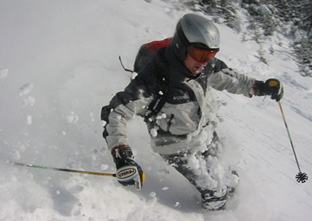
The general public benefits too
Just like the pros
There are few sports where "amateurs" can practice their talents with exactly the same equipment as that used by professionals. Skiing and all its variants are no exception to the rule. This goes far beyond simple marketing as is so often seen in other sports. If you so desire, you can hit the slopes with the same skis and boots as your idol. Note, however, that this equipment is highly technical and requires an enormous amount of prior practice, without which the first corner could create unexpected results! Manufacturers are developing ranges of products for less experienced skiers. Featherweight skis for better manoeuvrability! This particular feat was achieved thanks to polyurethane, a polymer whose low viscosity facilitates the moulding of the core.


This type of configuration allowing a reduction of weight and an increase in flexibility can also be found in ski boots and more particularly in boots used for cross-country skiing, touring and freeriding. Pebax®, a high-tech polymer developed by Arkema, meets the requirements of winter sport equipment designers exactly. In addition to its flexibility, this high-end thermoplastic is unaffected by extreme cold and offers a high resistance to impact and fatigue. Its molecular design allows innovative designs which can be shaped to be in perfect harmony with human morphology. Finally, a new technique has recently garnered a lot of success: boot fitting. The flexibility of plastic materials allows ski boots to be fitted with 100% comfort to most users' feet. The shell and the liner, after having been preheated, can be permanently shaped to better follow the contours of their owner's feet.
Wrapped up cosy and warm
 Long gone are the days of those "old" woollen jumpers. Although they were relatively warm, they had one insurmountable design flaw: they retained moisture and obstructed all incoming heat. What remains of that glorious time when the highest peaks were being conquered one after the other? Fortunately, not much, except for the knowledge of how to dress before going out to face the cold weather - in February, temperatures often dip to around -15° C at only 2,000 meters above sea level. Winter sports enthusiasts know well that there is no point in wearing layer upon layer, and that three layers are enough.
Long gone are the days of those "old" woollen jumpers. Although they were relatively warm, they had one insurmountable design flaw: they retained moisture and obstructed all incoming heat. What remains of that glorious time when the highest peaks were being conquered one after the other? Fortunately, not much, except for the knowledge of how to dress before going out to face the cold weather - in February, temperatures often dip to around -15° C at only 2,000 meters above sea level. Winter sports enthusiasts know well that there is no point in wearing layer upon layer, and that three layers are enough.
Layer upon layers
The first layer is known as the breathable layer; it is this layer which retains body heat and repels moisture outwards. Polyester is required to achieve this. It is often enriched with spandex to improve its flexibility, providing a "stretch" effect. This type of underwear stays close to the skin while being elastic enough to be hardly noticeable. The insides of the high-end models are even lined with polypropylene which remains dry against the skin even at the peak of exercise thanks to the efficiency with which it wicks moisture.


The second layer is the insulating layer. Its sole function is to prevent heat loss by maintaining an envelope of warm air around the body. It is the air trapped around the body which acts as a barrier against the cold. The thickness of the layer can be adapted to fit outside temperatures. Fleece made from polyethylene terephthalate (PET) remains the leading material in this product category. For mountaineers, it is primarily a technical garment whose complex shapes and assembly combine various materials according to their density and their intrinsic characteristics. The reason for this complexity is that areas of perspiration areas are not uniformly distributed over the human body. As for flexibility, it is obviously much more important in joints such as the elbows, which is where there is the most spandex.

Then comes the third and final layer which is crucial in its own way. Coats, jacket and parkas have to keep the wearer warm while also providing insulation and protection from wind and rain. Here again, there is an abundance of choice and innovations. Assuming that a good technical garment must be able to go unnoticed, careful attention is paid to the cut of the garment in order to provide skiers with a significant amount of freedom of movement. But that's not all; far from it. Gore-tex, a Teflon-based micro-porous laminated membrane (PTFE) came onto the market a few years ago. The revolutionary synthetic material blocks outside air from getting inside while allowing the evacuation of moisture resulting from perspiration. Most modern jackets are made from Gore-tex, and the most advanced models do not even have seams in order to avoid any air getting in... They are assembled by gluing and the zippers are completely insulated through the use of Velcro.
Nanotechnology for futuristic clothing
The revolution of synthetic technical fibres is only just getting started; integrating microcapsules into the fibres is already a reality. The next generation of clothing might bring a range of new possibilities, such as automatically delivering a dose of sugar, for instance, through the pores of the skin to avoid hypoglycaemia. This is just one of myriad examples given that the bounds of manufacturers' imaginations are limitless when it comes to keeping one step ahead of the competition.

When plastics protect

It is a fact that polymers have contributed to many sporting achievements, often in excellent comfort. However, in the majority of cases, enhancing performance can be synonymous with the risk of injury from falls or impacts. Helmets are crucial for protecting against such trauma and have long been mandatory in all competitions. Helmets are made up of two main parts: the shell (carbon fibre, fibreglass or polycarbonate) and a shock-absorbent polystyrene foam. Once again, perfect mastery of manufacturing techniques enables the design of aerodynamic and ventilated helmets. The same goes for glasses and other masks which are amalgams of various polymers which not only reflect UV rays but also enable the wearer to see in foggy conditions - all achieved with just under a few grams.
Skiing in any season

They are beginning to pop up in valleys all over the world, for the greatest pleasure of winter sports enthusiasts who enjoy skiing and ice skating. "They", of course, are the artificial skiing slopes made from vinyl-based polymer. Although they do not exactly feel like real snow, they are definitely close. They are currently still quite few and far between, but manufacturers are working hard to come up with the right formula and the perfect polymer which will let skiers glide down the slopes in style. It is only a matter of time before you'll be able to ski close to home in any season provided that the terrain is suitable for accommodating a skiing slope.





